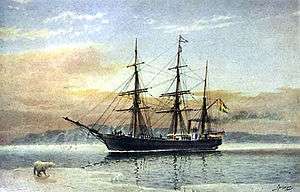Vega Expedition



_(14799670933).jpg)
The Vega Expedition (Swedish: Vegaexpeditionen) of 1878–1880, under the leadership of Adolf Erik Nordenskiöld, was the first Arctic expedition to navigate through the Northeast Passage, the sea route between Europe and Asia through the Arctic Ocean, and the first voyage to circumnavigate Eurasia.[1] Initially a troubled enterprise, the successful expedition is considered to be among the highest achievements in the history of Swedish science.
Preparations
Nordenskiöld had already conducted a series of expeditions in the Arctic, including to Svalbard, West Greenland, the Kara Sea and the Yenisei River.
In 1877 Nordenskiöld began planning the expedition to find the Northeast Passage, and in July he presented a detailed plan to King Oscar II, who accepted the proposal. Additional funds were provided by members of the Swedish Society for Anthropology and Geography and the Royal Society of Sciences and Letters in Gothenburg, and private individuals, notably Oscar Dickson and the Russian Alexander Sibiryakov.
The steamship Vega, constructed in 1872 at Bremerhaven as a sealer and whaler, was bought for the expedition, and was converted at the Karlskrona naval shipyards in Blekinge in Sweden, with government funding. Sibiryakov also equipped another steamship, "Lena", which would accompany the expedition until the Lena River in Siberia.
Expedition members
Louis Palander was appointed captain of the expedition. Palander was an experienced sailor who had already made several trips in the Arctic and had previously participated in other Nordenskiöld expeditions. It also included scientists, officers and a crew of 21 men.
Noted members of the international team included:
- Ernst Almqvist, Swedish doctor, botanist and lichenologist
- Charles John Andersson, Swedish travel writer and explorer
- Giacomo Bove, Italian sailing master, in charge of the Marine chronometers and made the astronomical observations needed to fix the ship's position
- Andreas Peter Hovgaard, Danish naval officer, explorer and meteorologist, responsible for the meteorological and magnetic observations
- Frans Reinhold Kjellman, Swedish botanist
- Oscar Frithiof Nordquist, Finnish hydrographer and zoologist, acted as the Russian interpreter
- Anton Stuxberg, Swedish zoologist
See also
- Albatross expedition (1947–48), Swedish oceanographic expedition
- Cape Vega, a headland in the Kara Sea named after the ship.
- History of research ships